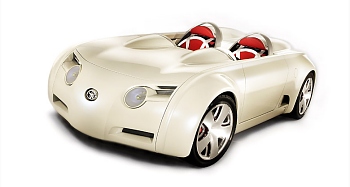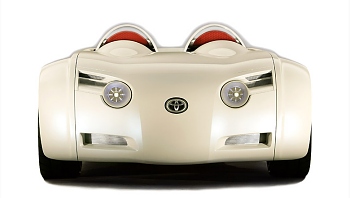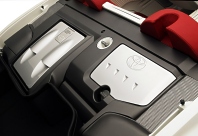
.
. .
..
. . .
Related Topics:
© 1998 - 2006 Copyright & |
Toyota: CSS Concept
CS&S combines sportiness and eco-friendliness in an unique intelligent package The Frankfurt Motor Show was the venue for the world launch of the striking CS&S (Compact Sports & Specialty) sports concept car.
This brand new Toyota concept focuses on three specific areas:
In essence the CS&S is positioned somewhere between the current Celica and MR2 models. It’s a mid-engined 2+2 open sports car powered by a 1.5-litre petrol unit that drives the rear wheels, while the front wheels are powered by an electric motor. It thus offers both economy because of the relatively small conventional engine, together with four-wheel drive and strong acceleration thanks to the electric motor’s high torque. What CS&S proves is that hybrid technology is not just eco-friendly. It can also provide a dynamic and highly enjoyable driving experience, thanks to a unique combination of low kerb weight, four-wheel drive and a powerful 2nd generation hybrid powertrain. Big innovation in a small car
At first glance CS&S looks like a radical, high-tech and futuristic open twoseater sports car. But in fact, removable rear canopies hide a further two seats, making this a true 2+2 sports car.
These have the effect not only of providing an individual space for the driver and passenger, but also emphasising the car’s sporty image. On the show car, the white exterior is graphically contrasted for maximum effect by the red interior trim colour.
The CS&S body has a distinct proportion: short, wide and low. The extremely low centre of gravity and a wide base benefit driving dynamics. Body height is 1120 mm, 12 centimetres lower than a Toyota MR2. With an exterior width of 1,800 mm, this car is also 6.5 centimetres wider than a Toyota Celica. A long wheelbase (2550 mm for a length of 3940 mm) creates a bold stance and provides a smarter package.
Hybrid Synergy Drive – energetic performance with environmental care
The concept of Hybrid Synergy Drive gives the electric motor a more important role when powering the vehicle both for fuel efficiency or peak performance. Therefore the electric motor is much more powerful than before, which means the petrol engine actually is used less. As the electric motor is much more efficient than the petrol unit, this will also be translated into better fuel economy, in spite of the improved performance. Toyota’s intention in developing the Hybrid Synergy Drive philosophy is to introduce more powerful petrol and electric power sources in order to achieve higher levels of performance. The second generation Prius – and the CS&S concept – prove that hybrid vehicles, far from being dull and boring, can deliver driving dynamics that allow them to compete head-to-head even with conventional sports cars. Ice-cool technology As well as its innovative Hybrid Synergy Drive system, the CS&S unveils another radical new IT concept – Toyota Space Touch. At its heart is an integrated multimedia system that is operated via a series of holographic projections that the user ‘touches’ to make a selection. Spheres of information appear to float in space, but when touched they allow the user to control functions such as the air conditioning, audio, satellite navigation and others. Even users wholly unfamiliar with the equipment will find it simple and intuitive to use. Toyota Space Touch also manages to break new ground in terms of human-machine interface. For instance, several audio adjustments can be changed in a very simple operation. The built-in navigation system can be operated in an intuitive way, which is a major improvement compared with some systems available on the market. Finally, Toyota Space Touch allows the user to browse through the internet, as well as sending and receiving e-mails, always in an intuitive and straightforward manner. All pictures: Lexus Corp.
|
.
.
|

















